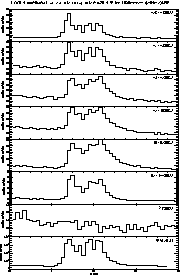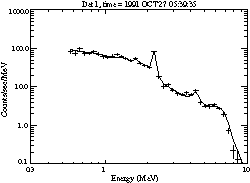Back To OSSE Solar Flare Web Page
1991 October 27 (X6.1)
A GOES X6.1 solar flare occurred on 1991 October 27 at an H-alpha location of S13E15 (heliographic coordinates). The soft X-ray flux began at 5:37 (20220 s), peaked at 5:48 (20880 s), and ended at 7:12 (25920 s) UT. OSSE received a BATSE transient trigger at 20349 s UT while OSSE was observing Centaurus A, but, because the source position calculated on-board by BATSE was outside the acceptance window for a solar source, OSSE did not respond except to alter some data collection parameters. The position of the Sun was ~30 degrees off the collimator axis resulting in strong attenuation of <1 MeV solar photons. However, the flare was intense enough to allow a significant fraction of the >1 MeV gamma-ray emission to penetrate the shields and be detected by the central detectors. Because of the strong low-energy attenuation, the preliminary results presented here are based on an analysis of >0.55 MeV data only.
Gamma-ray emission showing evidence of nuclear lines began at about 20374 s UT and lasted until about 20895 s UT, exhibiting two peaks of about 60-s duration each. The 2.223 MeV neutron-capture line was also observed and continued until about 21200 s UT. Count rate time profiles in various energy windows at a temporal resolution of ~16 s are shown in Figure 1. A count spectrum obtained from one detector summed over the interval 20375-20653 s UT is shown in Figure 2.
Gamma-ray lines at 1.6, 2.223, 4.4, 6.1 and 7 MeV can be seen. The total fluences of the 2.223 MeV line and of narrow nuclear lines >1 MeV were 141 +/- 3 and 63 +/- 3 photons cm-2, respectively. Because the fit was performed only above 0.55 MeV, the electron bremsstrahlung component is not well-determined. No evidence for >16 MeV gamma-ray emission was seen but a weak neutron signal beginning after the ~MeV gamma-ray emission had peaked was detected. After satellite night (at about 21600 s UT), this signal fell to zero as expected for a solar source.
The measured fluence ratio of the 6.13 MeV 16O and 1.63 MeV 20Ne narrow lines can be converted to a spectral index of the ~5-20 MeV nucleon-1 accelerated particles using the calculations of Ramaty et al. (1996). Assuming a power-law form for the spectrum, the derived index is ~3. Alternatively, the fluence ratio of the neutron-capture and the 4.44 MeV 12C lines can be converted to a spectral index for the ~10-100 MeV nucleon-1 accelerated particles. We find that the index derived with this latter technique is softer than that derived from the O/Ne fluence ratio. This suggests that the accelerated-particle spectrum of this flare steepens above ~50 MeV which is consistent with both the lack of detected >16 MeV pion-decay emission at the peak of the flare and the fact that the neutron yield per nuclear gamma ray for this flare is low (at least a factor of two lower than that for the 1991 June 4 flare).
This flare was also well-observed with the Gamma Ray Spectrometer on board Yohkoh. These coincident data will allow a relative calibration of these two instruments in preparation for future joint observations of solar flares during Solar Cycle 23.
References: Ramaty, R., Mandzhavidze, N., and Kozlovsky, B. 1996, in AIP Conf. Proc. 374, High Energy Solar Physics, ed. R. Ramaty, N. Mandzhavidze, & X.-M. Hua (New York:AIP), 172.
 Figure 1 |
 Figure 2 |